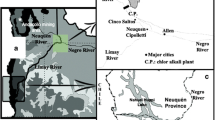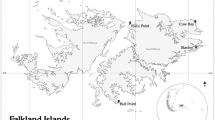Abstract
Given their central role in mercury (Hg) excretion and suitability as reservoirs, bird feathers are useful Hg biomonitors. Nevertheless, the interpretation of Hg concentrations is still questioned as a result of a poor knowledge of feather physiology and mechanisms affecting Hg deposition. Given the constraints of feather availability to ecotoxicological studies, we tested the effect of intra-individual differences in Hg concentrations according to feather type (body vs. flight feathers), position in the wing and size (mass and length) in order to understand how these factors could affect Hg estimates. We measured Hg concentration of 154 feathers from 28 un-moulted barn owls (Tyto alba), collected dead on roadsides. Median Hg concentration was 0.45 (0.076–4.5) mg kg−1 in body feathers, 0.44 (0.040–4.9) mg kg−1 in primary and 0.60 (0.042–4.7) mg kg−1 in secondary feathers, and we found a poor effect of feather type on intra-individual Hg levels. We also found a negative effect of wing feather mass on Hg concentration but not of feather length and of its position in the wing. We hypothesize that differences in feather growth rate may be the main driver of between-feather differences in Hg concentrations, which can have implications in the interpretation of Hg concentrations in feathers. Finally, we recommend that, whenever possible, several feathers from the same individual should be analysed. The five innermost primaries have lowest mean deviations to both between-feather and intra-individual mean Hg concentration and thus should be selected under restrictive sampling scenarios.





Similar content being viewed by others
References
Ackerman JT, Eagles-Smith CA (2010) Agricultural wetlands as potential hotspots for mercury bioaccumulation: experimental evidence using caged fish. Environ Sci Technol 44(4):1451–1457. doi:10.1021/es9028364
Ackerman JT, Miles AK, Eagles-Smith CA (2010) Invertebrate mercury bioaccumulation in permanent, seasonal, and flooded rice wetlands within California’s Central Valley. Sci Total Environ 408(3):666–671. doi:10.1016/j.scitotenv.2009.10.030
Agusa T, Matsumoto T, Ikemoto T, Anan Y, Kubota R, Yasunaga G, Kunito T, Tanabe S, Ogi H, Shibata Y (2005) Body distribution of trace elements in black-tailed gulls from Rishiri Island, Japan: age-dependent accumulation and transfer to feathers and eggs. Environ Toxicol Chem 24(9):2107–2120. doi:10.1897/04-617R.1
Barton K (2015) MuMIn: multi-model inference. R package version 1.13.4. http://CRAN.R-project.org/package=MuMIn. Accessed 12 August 2014
Berg W, Johnels A, Sjöstrand B, Westermark T (1966) Mercury content in feathers of Swedish birds from the past 100 years. Oikos 17(1):71–83. doi:10.2307/3564782
Bortolotti G (2010) Flaws and pitfalls in the chemical analysis of feathers: bad news–good news for avian chemoecology and toxicology. Ecol Appl 20(6):1766–1774. doi:10.1890/09-1473.1
Braune BM (1987) Comparison of total mercury levels in relation to diet and molt for nine species of marine birds. Arch Environ Contam Toxicol 16(2):217–224. doi:10.1007/BF01055802
Bunn DS, Warburton AB, Wilson RDS (1982) The Barn Owl. T and AD Poyser, Calton
Burger J, Gochfeld M (1997) Risk, mercury levels, and birds: relating adverse laboratory effects to field biomonitoring. Environ Res 75(2):160–172. doi:10.1006/enrs.1997.3778
Burnham KP, Anderson DR (2002) Model selection and multimodel inference: a practical information-theoretic approach. Springer-Verlag, New York
Burnham KP, Anderson DR, Huyvaert KP (2011) AIC model selection and multimodel inference in behavioural ecology: some background, observations, and comparisons. Behav Ecol Sociobiol 65(1):23–35. doi:10.1007/s00265-010-1029-6
Bustnes JO, Bårdsen B-J, Bangjord G, Lierhagen S, Yoccoz NG (2013) Temporal trends (1986–2005) of essential and non-essential elements in a terrestrial raptor in northern Europe. Sci Total Environ 458–460:101–106. doi:10.1016/j.scitotenv.2013.04.027
Calle P, Alvarado O, Monserrate L, Cevallos JM, Calle N, Alava JJ (2015) Mercury accumulation in sediments and seabird feathers from the Antarctic Peninsula. Mar Pollut Bull 91(2):410–417. doi:10.1016/j.marpolbul.2014.10.009
Castro I, Aboal JR, Fernández JA, Carballeira A (2011) Use of raptors for biomonitoring of heavy metals: gender, age and tissue selection. B Environ Contam Tox 86(3):347–351. doi:10.1007/s00128-011-0220-4
Chen H, Teng Y, Lu S, Wang Y, Wang J (2015) Contamination features and health risk of soil heavy metals in China. Sci Total Environ 512–513:143–153. doi:10.1016/j.scitotenv.2015.01.025
Costley CT, Mossop KF, Dean JR, Garden LM, Marshall J, Carroll J (2000) Determination of mercury in environmental and biological samples using pyrolysis atomic absorption spectrometry with gold amalgamation. Anal Chim Acta 405(1–2):179–183. doi:10.1016/S0003-2670(99)00742-4
Dauwe T, Bervoets L, Pinxten R, Blust R, Eens M (2003) Variation of heavy metals within and among feathers of birds of prey: effects of molt and external contamination. Environ Pollut 124(3):429–436. doi:10.1016/S0269-7491(03)00044-7
Denneman WD, Douben PET (1993) Trace metals in primary feathers of the barn owl (Tyto alba guttatus) in the Netherlands. Environ Pollut 82(3):301–310. doi:10.1016/0269-7491(93)90133-9
Dietz R, Riget F, Cleeman M, Aarkrog A, Johansen P, Hansen JC (2000) Comparison of contaminants from different trophic levels and ecosystems. Sci Total Environ 245(1–3):221–231. doi:10.1016/S0048-9697(99)00447-7
Espín S, Martínez-López E, León-Ortega M, Calvo JF, García-Fernández AJ (2014) Factors that influence mercury concentrations in nestling Eagle Owls (Bubo bubo). Sci Total Environ 470–471:1132–1139. doi:10.1016/j.scitotenv.2013.10.063
Evans HL, Garman RH, Laties VG (1982) Neurotoxicity of methylmercury in the pigeon. Neurotoxicology 3(3):21–36
Furness RW, Muirhead SJ, Woodburn M (1986) Using bird feathers to measure mercury in the environment: relationships between mercury content and moult. Mar Poll Bull 17:27–30. doi:10.1016/0025-326X(86)90801-5
García-Férnandez AJ, Calvo JF, Martínez-López E, María-Mojica P, Martínez JE (2008) Raptor ecotoxicology in Spain: a review on persistent environmental contaminants. Ambio 37(6):401–407. doi:10.1579/0044-7447(2008)37
Gomes L, Grilo C, Silva C, Mira A (2009) Identification methods and deterministic factors of owl road kill hotspot locations in Mediterranean landscapes. Ecol Res 24(2):355–370. doi:10.1007/s11284-008-0515-z
Gómez-Ramírez P, Shore RF, van den Brink NW, van Hattum B, Bustnes JO, Duke G, Fritsch C, García-Fernández AJ, Helander BO, Jaspers V, Krone O, Martínez-López E, Mateo R, Movalli P, Sonne C (2014) An overview of existing raptor contaminant monitoring activities in Europe. Environ Int 67:12–21. doi:10.1016/j.envint.2014.02.004
Grilo C, Reto D, Filipe J, Ascensão F, Revilla E (2014) Understanding the mechanisms behind road effects: linking occurrence with road mortality in owls. Anim Conserv 17(6):555–564. doi:10.1111/acv.12120
Honda K, Min BY, Tatsukawa R (1986) Distribution of heavy metals and their age-related changes in the eastern great white egret (Egretta alba modesta) in Korea. Arch Environ Contam Toxicol 15(2):185–197. doi:10.1007/BF01059967
Jackson A, Evers D, Etterson M, Condon A, Folsom S, Detweiler J, Schmerfeld J, Cristol DA (2011) Mercury exposure affects the reproductive success of a free-living terrestrial songbird, the Carolina Wren (Thryothorus ludovicianus). Auk 128(4):759–769. doi:10.1525/auk.2011.11106
Jiang W, Hou Q, Yang Z, Yu T, Zhong C, Yang Y, Fu Y (2014) Annual input fluxes of heavy metals in agricultural soil of Hainan Island, China. Environ Sci Pollut R 21(13):7876–7885
Krabbenhoft DP, Sunderland EM (2013) Global change and mercury. Science 341:1457–1458
Lenton GM (1984) Moult of Malayan Barn Owls Tyto alba. Ibis 126(2):188–197. doi:10.1111/j.1474-919X.1984.tb07998.x
Lewis SA, Furness RW (1991) Mercury accumulation and excretion in laboratory reared black-headed gull Larus ridibundus chicks. Arch Environ Contam Toxicol 21(2):316–320. doi:10.1007/BF01055352
Lindberg P, Odsjö T (1983) Mercury levels in feathers of peregrine falcon Falco peregrinus compared with total mercury content in some of its prey species in Sweden. Environ Pollut 5(4):297–318. doi:10.1016/0143-148X(83)90023-X
Lourenço R, Tavares PC, Delgado MM, Rabaça JE, Penteriani V (2002) Superpredation increases mercury levels in a generalist top predator, the eagle owl. Ecotoxicology 20(4):635–642. doi:10.1007/s10646-011-0603-7
Martínez JA, Zuberogoitia I, Alonso R (2002) Rapaces nocturnas. Guía para la determinación de la edad y el sexo en las estrigiformes ibéricas. Monticola Ediciones, Madrid
Pinheiro JC, Bates DM (2000) Mixed-effects models in S and S-PLUS. Springer, New York
Pinheiro J, Bates D, DebRoy S, Sarkar D, R Core Team (2015) nlme: linear and nonlinear mixed effects models. R package version 3.1-120. http://CRAN.R-project.org/package=nlme. Accessed 12 August 2014
Quinn GP, Keough G (2002) Experimental design and data analysis for biologists. Cambridge University Press, Cambrigde
R Core Team (2014) R: a language and environment for statistical computing. R Foundation for Statistical Computing, Vienna, Austria. http://www.R-project.org/. Accessed 12 August 2014
Roulin A (2002) Barn Owl. BWP Update 4:115–138
Scheuhammer AM, Meyer MW, Sandheinrich MB, Murray MW (2007) Effects of environmental methylmercury on the health of wild birds, mammals, and fish. Ambio 36(1):12–18
Seewagen CL (2010) Threats of environmental mercury to birds: knowledge gaps and priorities for future research. Bird Conserv Int 20(2):112–123. doi:10.1017/S095927090999030X
Silva CC, Lourenço R, Godinho S, Gomes E, Marques HS, Medinas D, Neves V, Silva C, Rabaça JE, Mira A (2008) Major roads have a negative impact on the Tawny Owl Strix aluco and the Little Owl Athene noctua populations. Acta Ornithol 47(1):47–54. doi:10.3161/000164512X653917
Solonen T, Lodenius M (1990) Mercury in Finnish Sparrowhawks Accipiter nisus. Ornis Fennica 61(2):58–63
Warnes GR, Bolker B, Bonebakker L, Gentleman R, Liaw WHA, Lumley T, Maechler M, Magnusson A, Moeller S, Schwartz M, Venables B (2015) gplots: various R programming tools for plotting data. R package version 2.16.0. URL: http://CRAN.R-project.org/package=gplots. Assessed 12 August 2014
Westermark T, Odsjö T, Johnels AG (1975) Mercury content of bird feathers before and after Swedish ban on alkyl mercury in agriculture. Ambio 4(2):87–92
Windham-Myers L, Marvin-DiPasquale M, Stricker CA, Agee JL, Kieu LH, Kakouros E (2014) Mercury cycling in agricultural and managed wetlands of California, USA: experimental evidence of vegetation-driven changes in sediment biogeochemistry and methylmercury production. Sci Total Environ 484(1):300–307. doi:10.1016/j.scitotenv.2013.05.028
Yu M, Wu P, Widelitz RB, Chuong C-M (2002) The morphogenesis of feathers. Nature 420:308–312. doi:10.1038/nature01196
Acknowledgments
IR was supported by a doctoral Grant (SFRH/BD/72163/2010), and RL and JPC by post-doctoral degree Grants (BPD/78241/2011 and BPD/102870/2014, respectively) from Fundação para a Ciência e a Tecnologia—Portugal. Fieldwork was partly supported by QREN/INALENTEJO 2007–2013 under the project ECOMEDBIRDS (ALENT-04-0331-FEDER000205) and by Companhia das Lezírias, S.A. through a Business & Biodiversity Protocol with the University of Évora, under the project TYTOTAGUS.
Author information
Authors and Affiliations
Corresponding author
Ethics declarations
Conflict of interest
The authors have no known conflicts of interest associated with this publication and there has been no financial support for this work that could have influenced its outcome.
Human and animal rights
All samples were obtained under the permits of Instituto da Conservação da Natureza e das Florestas (Portugal) numbers: 40, 204-205, 265/2009/CAPT; 165-166/2010/CAPT and 258-260/2012/CAPT (IR, RL and AM). All applicable international, national, and/or institutional guidelines for care and use of animals were followed.
Rights and permissions
About this article
Cite this article
Roque, I., Lourenço, R., Marques, A. et al. Barn owl feathers as biomonitors of mercury: sources of variation in sampling procedures. Ecotoxicology 25, 469–480 (2016). https://doi.org/10.1007/s10646-015-1604-8
Accepted:
Published:
Issue Date:
DOI: https://doi.org/10.1007/s10646-015-1604-8




